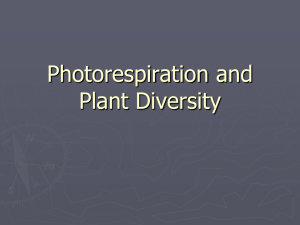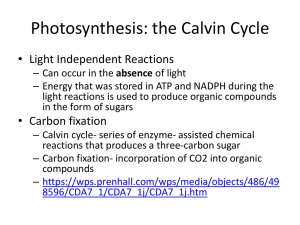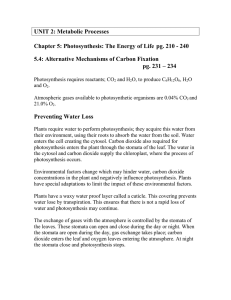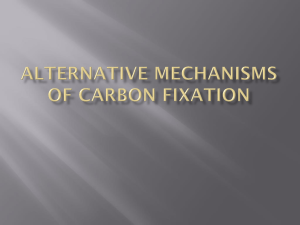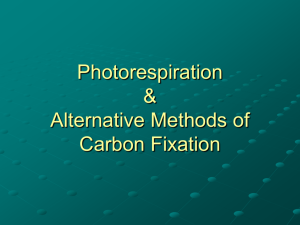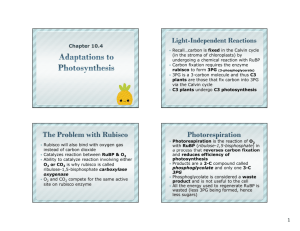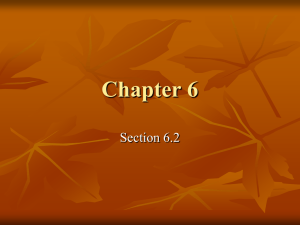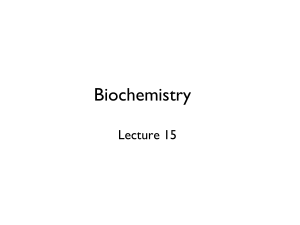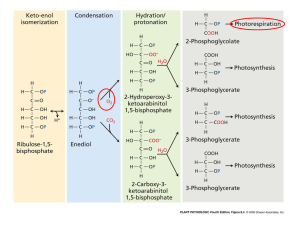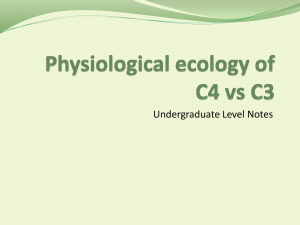Ch28 - FacStaff Home Page for CBU
advertisement
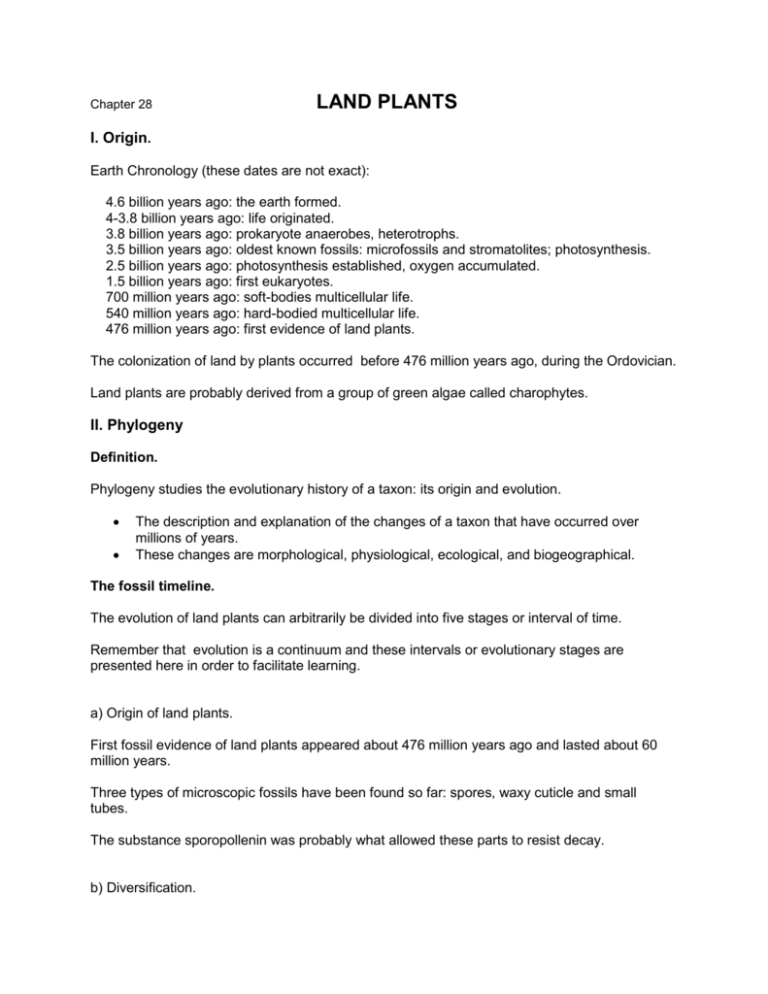
Chapter 28 LAND PLANTS I. Origin. Earth Chronology (these dates are not exact): 4.6 billion years ago: the earth formed. 4-3.8 billion years ago: life originated. 3.8 billion years ago: prokaryote anaerobes, heterotrophs. 3.5 billion years ago: oldest known fossils: microfossils and stromatolites; photosynthesis. 2.5 billion years ago: photosynthesis established, oxygen accumulated. 1.5 billion years ago: first eukaryotes. 700 million years ago: soft-bodies multicellular life. 540 million years ago: hard-bodied multicellular life. 476 million years ago: first evidence of land plants. The colonization of land by plants occurred before 476 million years ago, during the Ordovician. Land plants are probably derived from a group of green algae called charophytes. II. Phylogeny Definition. Phylogeny studies the evolutionary history of a taxon: its origin and evolution. The description and explanation of the changes of a taxon that have occurred over millions of years. These changes are morphological, physiological, ecological, and biogeographical. The fossil timeline. The evolution of land plants can arbitrarily be divided into five stages or interval of time. Remember that evolution is a continuum and these intervals or evolutionary stages are presented here in order to facilitate learning. a) Origin of land plants. First fossil evidence of land plants appeared about 476 million years ago and lasted about 60 million years. Three types of microscopic fossils have been found so far: spores, waxy cuticle and small tubes. The substance sporopollenin was probably what allowed these parts to resist decay. b) Diversification. In a relatively short time of about 60 million years, plant diversified abundantly and colonized many land areas. Between 410 and 360 million years ago, the Silurian-Devonian Diversification Explosion took place. First roots, leaves, vascular tissue, wood, etc. appear in the fossil record. c) Primeval forests. First evidence of forests appears during the Carboniferous period, between 350 and 290 million years ago. Extensive deposits of coal packed with fossils of spores, trunks, wood, leaves, etc. Extensive forested swamps. d) The seed. This interval is dominated by seed plants called gymnosperms or naked-seed plants. This interval lasted from about 250 to 120 million years ago, from the late Permian to the early the Cretaceous. Modern gymnosperms include pines, spruces, firs, cycads and ginkgoes among others. Gymnosperms prefer dry habitats so paleontologists theorize that during this time, plants moved into dryer areas away from the swamps. Both wet and dry land habitats became colonized. e) Flowering plants or angiosperms. From the early Cretaceous to the present, the last 145 million years approximately. Flowers and covered seeds evolved. The evolution of plants is still going on. A Phylogeny of Land Plants. Paul Kenrick and Peter Crane collated morphological and molecular data to produce a phylogenetic tree that shows possible relationships between the different groups of land plants. See Fig. 28.2 on page 543. Some important points to consider about their phylogenetic tree. The oldest branches of the tree lead to a group of algae called "green algae." Land plants share with the green algae the following traits: 1. Chlorophyll a and b, xanthophylls (yellow carotenoids) and carotenes (orange carotenoids). 2. Store carbohydrates in the form of starch. 3. Cell wall made mostly of cellulose. 4. Details of the formation of the cell plate. 5. DNA and RNA sequences support their close relation to the charophytes. The ancestor of land plants probably came from a group of green algae called charophytes. Liverworts, hornworts and mosses are the earliest land plants. The Rhyniopsida, are the first group to show water-conducting cells called tracheids and are leafless. The lycopods, horsetails and ferns have vascular tissue, true leaves and reproduce by spores. Gymnosperms and angiosperms are the more recent groups. They have seed, complex leaves and have vascular tissue. Present day charophytes inhabit ponds and lakes. This supports the hypothesis that transition to land occurred from fresh water rather than salt water habitats. III. Adaptations to terrestrial environments. Desiccation or drying-out was a major adaptive problem to be solved in the conquest of the dry land. A transport system of water from the source, soil, to parts of the plant body had to be developed. Reproduction without the use of water to transport gametes presented another problem. Upright support was a third obstacle to be overcome. Preventing water loss: 1. Waxy cuticle to protect against desiccation. The cuticle is a waxy layer that covers many parts of the plant body. It is impermeable to water and prevents loss and absorption of water by the covered surfaces. The cuticle also prevents gas exchange. 2. Stomata for gas exchange and control of transpiration. The stoma (plural stomata) is an opening surrounded by specialized cells called guard cells. The stoma opens or closes as the guard cells change shape. When the guard cells become turgid, the stoma opens; when the guard cells lose water and become soft, the stoma closes. The opening and closing of the stomata allows plants to regulate gas exchange and water loss. The Rhyniopsida that lived about 385 million years ago, are the first plants to show stomata. Hornworts and mosses have stomata with guard cells. Liverworts have pores without guard cells. Transporting water. 1. Upright position. Aquatic plants are supported by water. Water is 1000 times denser than air. Air is not as buoyant. 400 million-year old fossils show that those plants grew upright. Cell wall contains lignin, a polymer, to strengthen and support upright structures. This adaptation appeared in several plant lineages. 2. Transport system or vascular tissue: Phloem for the transport of dissolved carbohydrates. Xylem for water and mineral transport. There are two modern type of cells specialized to transport water and solutes: Tracheids Dead at maturity. Long and tapered cells. Have secondary walls except at pits. Pits on lateral and end walls. Conduction of water and minerals. Appeared about 380 million years ago. Vessel elements Dead at maturity. Long and cylindrical cells joined end to end. Secondary cell wall except at pits. End walls have perforations. Conduction of water and minerals. Appeared about 250-270 million years ago. Transporting gametes and protecting the embryo. 1. The multicellular haploid phase called the gametophyte. Gametohytes produce gametes by mitosis. Fusion of gametes produces a diploid sporophyte. Multicellular gametangia made of a layer of sterile cells to protect gametes: Antheridia produce sperms. Archegonia produce eggs. After fertilization, the egg develops into a multicellular embryo within the archegonium. Alternation of generations. 2. The multicellular diploid phase is called the sporophyte. Sporophytes produce spores by meiosis. Germination of haploid spores produces a haploid gametophyte. Alternation of generations. 3. The flower. Appeared about 145 million years ago during the early Cretaceous. The flower is a modified branch apex, and is involved in sexual reproduction. Reproductive and accessory organs are normally arranged in whorls or circles of structures: Sepals, petals stamens, and carpels. The flower contributed to the success of angiosperms and their present dominant status. Coevolution of flower morphology and pollinators' behavior and anatomy contributed to more effective pollination and seed formation thus increasing the angiosperm reproductive advantage over other plants including the seed-producing gymnosperms. Pollination is the transfer of pollen from the anther to the stigma, part of the female organ of the flower. IV. The Calvin-Benson Cycle Plants have become adapted to capture light energy under different terrestrial environments. C4 Photosynthesis Review the Calvin Cycle of photosynthesis beginning on page 146 Two separate groups of scientists lead by H. Kotschack and Y. S. Karpilov found that radioactive carbon given to plant in carbon dioxide (14CO2) was incorporate in 4-carbon organic acids like malate and aspartate, rather than in the expected 3-phosphoglycerate (3PG) produced at the beginning of the Calvin Cycle. Hatch and Slack continued the research and found that the plants used by the previous two groups of scientists utilize two enzymes to fix carbon dioxide: Rubisco found in the bundle-sheath cells surrounding the vascular tissue of the leaf. PEP carboxylase found in the mesophyll cells of the leaf. PEP carboxylase has greater affinity for CO2 than rubisco and can fix CO2 when rubisco cannot. Hatch and Slack proposed a model to explain how the carbon fixed in the 4-C organic acids is used in the Calving Cycle. CO2 is fixed by PEP carboxylase in a 3-C compound called phosphoenolpyruvate, PEP, and form a 4-C organic acid. This occurs in the mesophyll of the leaf. The 4-C malate or aspartate then travels to the bundle-sheath cells and released the CO2 in a reaction catalyzed by rubisco that forms 3C phosphoglycerate, 3PG. The Calvin-Benson Cycle continues to form carbohydrates. The 4C organic acids travel to the bundle-sheath cells through plasmodesmata. Why this pathway? In C3 the first organic compound formed through the fixation of CO2 is 3PG. When conditions are hot and dry the stomata close and the concentration of CO2 inside the cell to decrease and the concentration of O2 to rise - why? The low level of carbon dioxide starves the Calvin Cycle. Under low CO2 and high O2, rubisco prefers the oxygen and adds oxygen to the Calvin Cycle. The product of the addition of oxygen results in the splitting of the molecule. One of the products is a 2C molecule that is exported from the chloroplasts and broken down in the mitochondria and peroxisomes to form CO2. This process is called photorespiration. Photorespiration utilizes organic material that normally would be used in the Calvin Cycle and produces no food. In some plants, photorespiration utilizes up to 50% of the carbon dioxide fixed by the Calvin cycle. Photorespiration decreases photosynthetic output. But in C4 plants... The mesophyll cells of C4 plants pump enough carbon dioxide inside the bundle-sheath cells keeping the concentration high enough for rubisco to accept CO2 rather than O2. This minimizes photorespiration and increases sugar production. This adaptation is advantageous in hot and dry climates with intense sunlight where plants must close the stomata to conserve water. Crassulacean Acid Metabolism or CAM This pathway was discovered in the members of the Crassulaceae family of plants. Like the C4 pathway, CAM increases the concentration of CO2 inside the cell. CAM occurs in plants that inhabit climates that are hot and dry and keep their stomata closed during the day, e. g. cacti. CAM plants close their stomata during the day in order to conserve water but this prevents carbon dioxide from entering the leaf. CAM plants open their stomata during the night when conditions are less hot and fix large amounts of CO2 in organic acids that are stored in vacuoles. During the day, the stomata close but sunlight is then utilized to carry on the light-dependent reactions. Sunlight is used to supply ATP and NADPH for the Calvin cycle. During the day, the organic acids stored in the vacuoles are broken down to release carbon dioxide to be fixed in the Calvin cycle, in the light-independent reactions. C4 and CAM pathways are similar in that carbon dioxide is incorporated into organic acids in both. But they differ in location and time: in C4 the fixation of CO2 is separated structurally from the Calvin cycle. In CAM the fixation of CO2 and the Calvin cycle occur in the same cell but at different times: night and day. These two pathways allow angiosperms to colonize very dry habitats. V. Human uses of plants. Man in different parts of the world domesticated plants at different times. Domestication of wild plants began about 10,000 years ago. Man selected plants consciously or unconsciously for his own benefit. As wild forms were brought under cultivation, some changes occurred: seeds became larger, fruits became sweeter, plant parts became non-poisonous, etc. Plants are at the base of the food chain. Plants are also utilize to make coal, firewood, clothing, paper Plant biologists are using DNA techniques to transfer genes to create plant varieties more suitable to a particular end.

